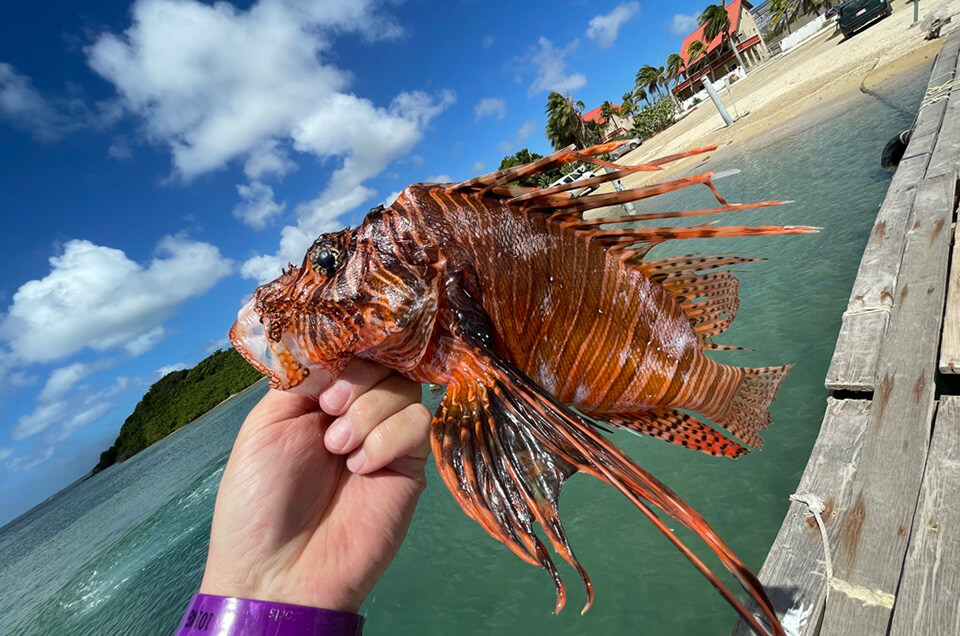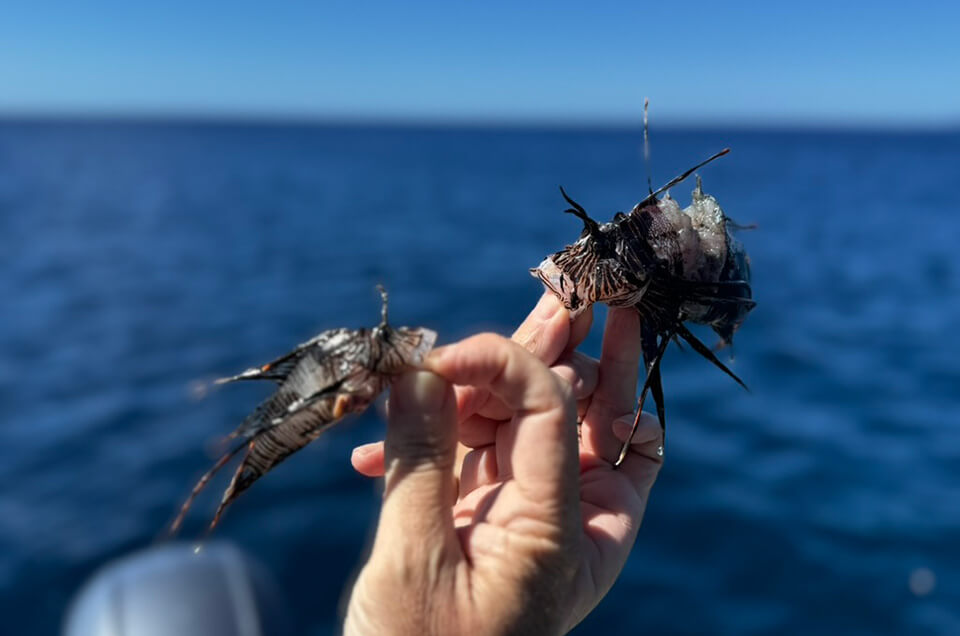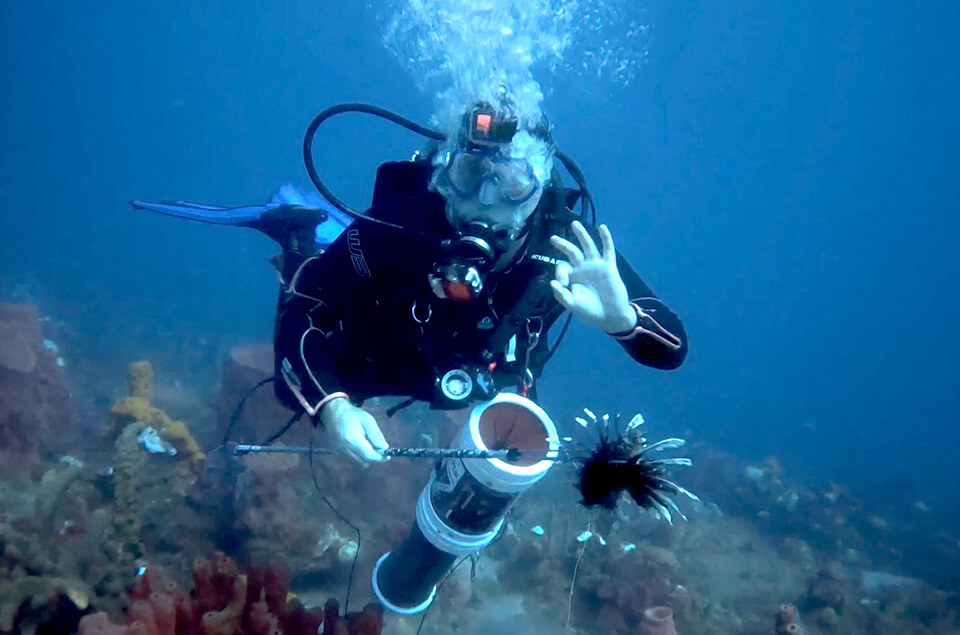Lionfish 101: What Are They?

What Are Lionfish?
A popular choice for home aquariums, the lionfish represents a category of carnivorous fish species, native to the Indo-Pacific part of the world. However, lionfish have become an invasive species in the Atlantic Ocean, wreaking havoc off the Eastern Coast of the United States and the Caribbean. Whether hunting off the shores of New Jersey or in international waters, Lionfishdivers.com is dedicated to removing as many lionfish from the ocean as possible. Learn more about what lionfish are and why this species is considered invasive.
About Lionfish
Lionfish are a type of venomous marine fish. Venomous means that a toxin is injected into the bloodstream, whereas poisonous means toxins are swallowed, inhaled, or absorbed through the skin.
There are several types of lionfish, but each share a commonality of venomous spines on tipped dorsal fins, as well as warning coloration (black or red stripes). While they originate in the tropical, warm seas in the South Pacific and Indian Ocean, including the Red Sea, lionfish are now considered an invasive species in the Atlantic Ocean, as they feed on native fish and damage underwater environments.
Here are some more facts about lionfish:
- Coloring: Lionfish can have a combination of white, orange, red, brown, and/or black scales.
- Conservation status: Lionfish are not extinct, threatened, or endangered.
- Habitat: You can find lionfish nesting in rocky crevices and tropical reefs.
- Lifespan: On average, lionfish live anywhere between 10-18 years.
- Predators: While eels, frogfish, and scorpion fish threaten lionfish in the Indo-Pacific, there are very few known predators in the Atlantic Ocean.
- Prey: Lionfish mainly feed on crabs, shrimp, and other fish.
Types of Lionfish
There are several types of lionfish, with more subspecies being discovered as time goes on. The three primary generas of lionfish include Nemapterois, Dendrochirus, and Pterois. Nemapterois and Dendrochirus lionfish are considered dwarf species, typically reaching 8”-10” in length, while Pterois lionfish can grow up to 16”.
Within the three lionfish generas are more than 16 known species. Here’s a breakdown of the most popular lionfish species, along with their scientific names:
African Lionfish (Pterois mombasae)
Also known as deepwater firefish or frillfin turkeyfish, they have a darker body than most lionfish species, along with white and dark brown stripes. They dwell in the growth of invertebrates and soft-bottomed areas of the ocean.
Clearfin Lionfish (Pterois radiata)
Sometimes referred to as Tailbar lionfish, this species is most visually unique, as these lionfish have black, white, and red stripes. Their body has tall dorsal fins and large pectoral fins, as well as heir fins that are transparent compared to other lionfish types. They’re usually found hiding in hard-to-reach places that offer a lot of swimming space.
Common Lionfish (Pterois miles)
Also known as devil firefish, this ray-finned type is commonly confused with red lionfish. The dorsal fin alone has 13 venomous spines, in addition to a tailfin with three of its own spines. Common lionfish range from tan to red to gray, with vertical dark stripes. They are most often found in South Florida outside of their native Indo-Pacific region.
Luna Lionfish (Pterois lunulata)
Referred to as a dragon’s beard fish, this species has the same venomous spines, stripped patterns, and brown, black, and red coloring as other lionfish. The difference comes in their length, as they are considered a medium-sized lionfish.
Red Lionfish (Pterois volitans)
These lionfish look almost identical to common lionfish, but they are one of the largest species, growing to around 18.5”. Maroon coloring is also noticeable in red lionfish. They have an average of 18 venomous spines and share similar habits to other types of lionfish.
Spotfin Lionfish (Pterois antennata)
Also known as ragged-finned firefish, this species usually has black, white, and red stripes, with sprawling pectoral fins and spiny dorsal fins. Because these fins lack connective tissue, spotfin lionfish can have a more bony appearance. Spotfin lionfish love to hide out in crevices and caves, and they can fit easily into these spaces due to their smaller size.
Why Are Lionfish Invasive?
Lionfish can repopulate at an amazing rate. For instance, female lionfish can release around 15,000 fertilized eggs at a time. Due to multiple factors, from overpopulated Indo-Pacific waters to climate change, lionfish have been invading the U.S. Atlantic coast, the Caribbean, and the Gulf of Mexico. However, much of the lionfish invasion is correlated with irresponsible fish tank owners, who dump their unwanted lionfish into the Atlantic Ocean.
Because they are not native to the Atlantic Ocean, lionfish don’t have many predators to worry about outside of the Indo-Pacific area. They eat most small crustaceans and fish, including snapper and grouper, commercial fish species whose young are on the lionfish’s prey list.
Once invasive species become established in their new habitats, the problem is virtually impossible to eliminate via conventional methods. The population will continue to grow rapidly, with females capable of dispersing 2,000,000 fertilized eggs per year. In the Atlantic Ocean, native fish populations have been struggling with the lionfish invasion for over 25 years.
For more information on the fish species and their effect on underwater ecosystems, check out this YouTube video from Lionfishdivers.com, translated into English and Spanish. You can also learn more from the Lionfish Educational Flip Book Vol. 1 and Vol. 2.
Hunting and Eating Lionfish
Lionfishdivers.com is led by Roger J. Muller, Jr., of Muller Insurance, an international lionfish hunter. When he’s not connecting clients with the right insurance coverage, he’s taking excursions around the world to track, hunt, and kill lionfish. This is an effort to help restore natural balance and prevent further coral reef degradation in the areas he fishes in.
Hunting lionfish takes the right hunting equipment and a lot of patience. Here are just a few of the items you’ll need:
- Spear
- Spear tips
- Containment device (i.e. zookeeper)
- First aid kits
- Puncture-resistant gloves
Since the venomous spines can cause very painful stings, lionfish safety is paramount while hunting. However, once the spine is removed, the fish is completely safe to cook and eat, and many believe it is quite delicious! You can get inspiration for preparing lionfish dishes from these cooking videos. What’s more, hunting and eating lionfish is a sustainable fishing option, so removing them from our waters is beneficial for more reasons than protecting ecosystems.
To learn more about lionfish and hunting for them, contact Roger J. Muller, Jr., at Lionfishdivers.com today.





